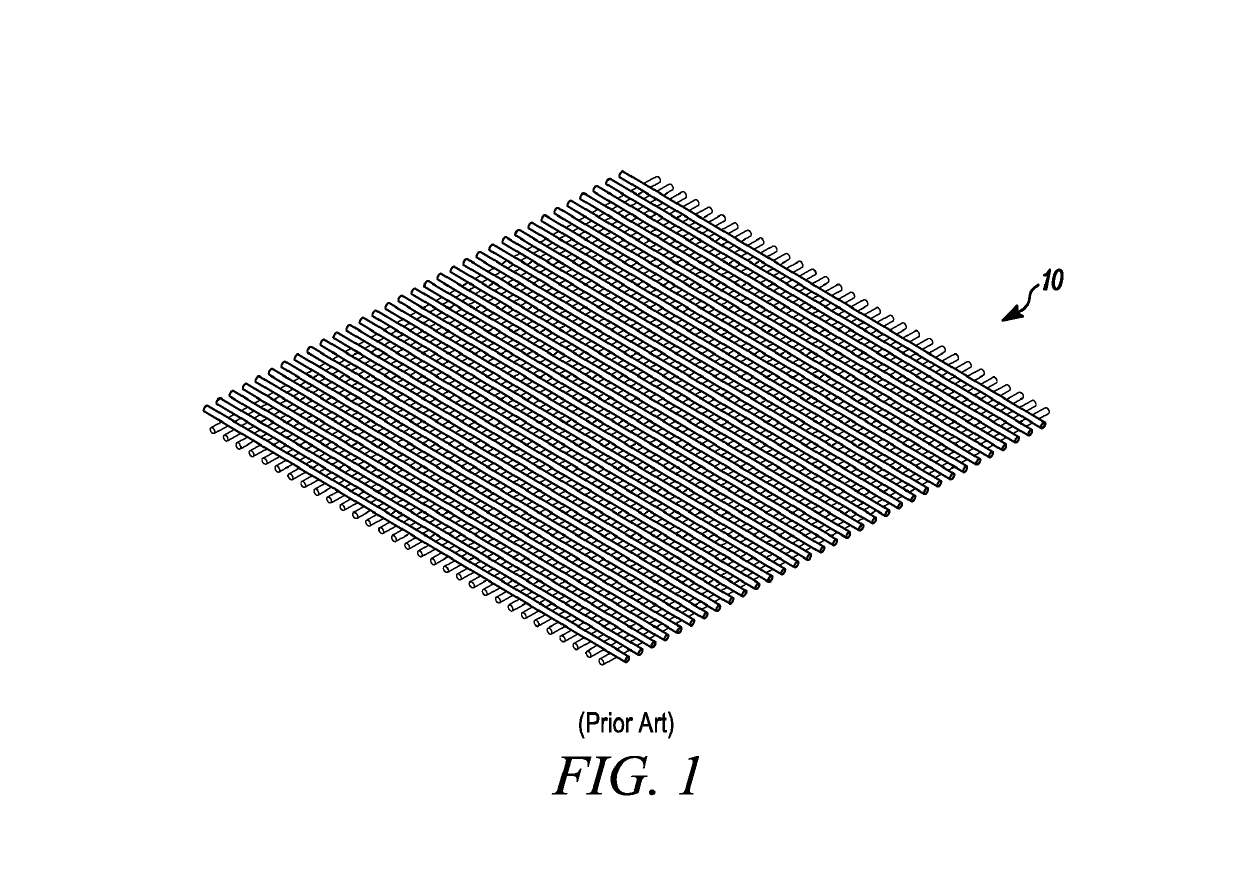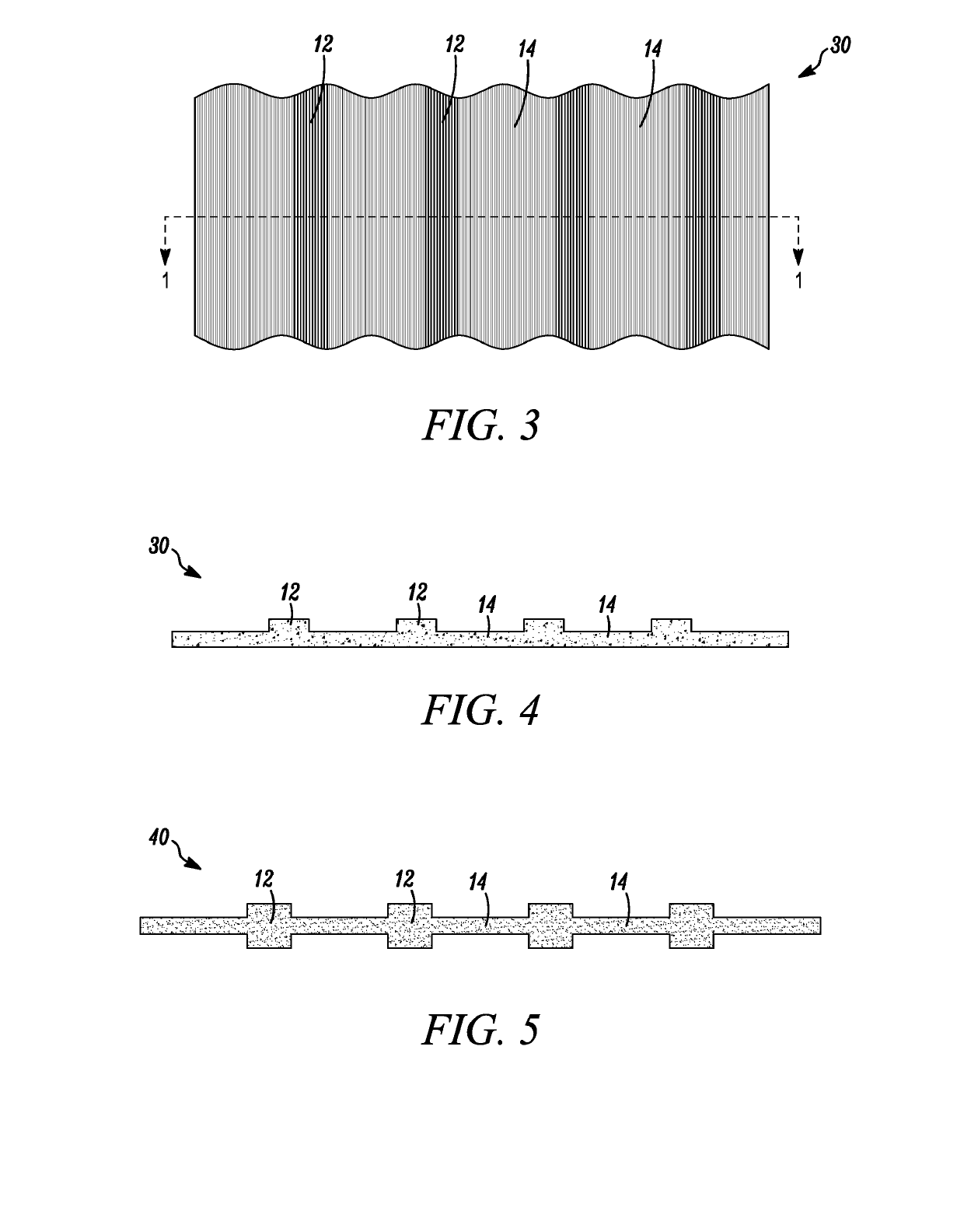Variable areal density cross-plied fiber-reinforced composite ballistic material
a fiber reinforced composite material and areal density technology, applied in the field of areal density cross-plied fiber reinforced composite ballistic materials, can solve the problems of reducing the ability of fibers to stay in tension, compromising effectiveness, and affecting the quality of woven stab/spike resistant fabric articles of the related art, and achieve the effect of enhancing article flexibility
- Summary
- Abstract
- Description
- Claims
- Application Information
AI Technical Summary
Benefits of technology
Problems solved by technology
Method used
Image
Examples
example 1
[0086]Several identical 38.1 cm×38.1 cm square stab / spike / ballistic resistant flexible packs are prepared for spike and stab testing. Each pack is formed by stacking together a group of layers of fabric A and a group of layers of fabric B. The layers in the stacks are not bonded to each other but are held together by taping together the four edges of the packs with generic commercially available packaging tape to hold the layers in the proper orientation during testing.
[0087]Each layer of fabric A is a non-uniform layer comprised of a single sheet (single ply) of non-woven, axially oriented (unidirectional) fibers having a non-uniform thickness and non-uniform areal density. The fibers are high strength, high modulus aramid fibers and the coated with a thermoplastic polyurethane polymer. The aramid fibers are manufactured by Teijin Inc. and have a breaking strength of 267 N and a Chord modulus of 91 GPa. Each A layer comprises 85% by weight of the fiber and 15% by weight of the poly...
example 2
[0091]An identical 38.1 cm×38.1 cm square flexible pack of this disclosure as produced in Example 1 is subjected to flexibility testing and compared to a commercially available stab resistant material (from Barrday, Inc. of Cambridge, Ontario, Canada) comprising a woven, coated aramid fabric. The comparative test sample was prepared by stacking 29 layers of the material and taping the edges of the stack as done for the new material of this disclosure. The flexibility test consists of flexing the test samples through an opening of approximately 100-mm (4 inches) and measuring extension (deflection) of the material when impacted with a metal ball plunger having a diameter of approximately 25 mm (1 inch). The plunger is lowered down to fabric extensions of 12.5 mm, 25 mm and 37 mm and the force required to reach these levels of fabric extension was measured by an Instron testing machine (Model 4505) to compare levels of flexibility of the two materials, both of which had identical area...
example 3
[0092]Three additional flexible packs of this disclosure similar to those formed in Example 1 are subjected to ballistic testing, except each pack has an areal density of 3.80 kg / m2. Each pack is subjected to ballistic testing separately on a calibrated clay backing against 9 mm, 127 grain FMS Remington bullets following National Institute of Justice test Standard NIJ 0101.06. Several of the bullets are fired to determine the industry standard V50 velocity for the material where half of the bullets were fired at a velocity to penetrate the shoot pack and the other half were fired at a reduced velocity so that bullets did not penetrate the shoot pack. The average V50 value of each of the three shoot packs is expected to be greater than 350 m / s.
PUM
| Property | Measurement | Unit |
|---|---|---|
| Length | aaaaa | aaaaa |
| Length | aaaaa | aaaaa |
| Thickness | aaaaa | aaaaa |
Abstract
Description
Claims
Application Information
 Login to View More
Login to View More - R&D
- Intellectual Property
- Life Sciences
- Materials
- Tech Scout
- Unparalleled Data Quality
- Higher Quality Content
- 60% Fewer Hallucinations
Browse by: Latest US Patents, China's latest patents, Technical Efficacy Thesaurus, Application Domain, Technology Topic, Popular Technical Reports.
© 2025 PatSnap. All rights reserved.Legal|Privacy policy|Modern Slavery Act Transparency Statement|Sitemap|About US| Contact US: help@patsnap.com



